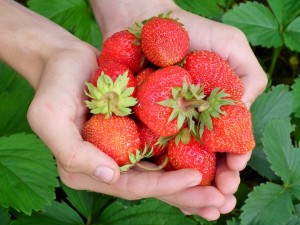This post by Madeleine Martiniello looks at findings from two new papers on strawberries published in BMC Genomics today, and is republished with kind permission from The Conversation.

If you’ve ever bitten into a strawberry and wondered why it doesn’t taste as sweet or as good as others in the punnet, you could blame the fruit’s genetics.
Two studies, published today in BMC Genomics, found that the distinct flavour of strawberry has been linked to a specific gene, present in some varieties of the fruit – but not in others.
The gene FaFAD1 controls a key flavour volatile compound in strawberries called gamma-decalactone, which is described as “fruity”, “sweet” or “peachy” and contributes to fruit aroma.
Andalusian Institute of Agricultural Research and Training (IFAPA) researcher Iraida Amaya said it was significant that the two studies arrived at the same conclusion using very diverse cultivars, because it suggests “that a marker in this gene would likely predict the presence/absence of the gene in breeding programs worldwide”.
Not all strawberries are created equal
Fruit flavour and aroma are determined by a combination of sugars, acids and volatile compounds. Strawberries have a complex volatile profile, made up of more than 360 volatile compounds, of which around 20 are considered to impact strawberry flavour.
The first BMC Genomics paper, by the IFAPA in Malaga, Spain, studied 20 breeding lines of strawberries, mostly originating from California, and the second paper, from the University of Florida, took an aromatic French strawberry variety.
Both showed that FaFAD1 was not present in fruits that did not produce gamma-decalactone.
 FaFAD1 encodes an enzyme – fatty-acid desaturase – which initiates production of the compound gamma-decalactone, activating in fruits (including peaches, plums, apricots, pineapples and strawberries) as they ripen.
FaFAD1 encodes an enzyme – fatty-acid desaturase – which initiates production of the compound gamma-decalactone, activating in fruits (including peaches, plums, apricots, pineapples and strawberries) as they ripen.
While the studies found that gamma-decalactone was undetectable in some lines of strawberry, its accumulation varied greatly within and between harvest seasons in others.
Using genomics-based strategies to identify genes controlling flavour, scientists will be able to design molecular markers to follow these genes in breeding populations.
Senior lecturer in agriculture Daniel Tan, from the University of Sydney, said: “The development of molecular markers are significant as these markers can be used to improve the understanding of the genetics of flavour in strawberry.”
This allows researchers to pinpoint strawberry varieties with a high likelihood of sweeter flavours.
Strawberry farming into the future
Strawberries are a valuable crop worldwide, yet modern farmers have often bred fruit for its size and yield, but not for taste.
The findings of these studies could finally merge these features, helping to “marry peachy flavour with other desirable berry traits,” David Tribe, a senior lecturer in food biotechnology from the University of Melbourne, said.
Professor of molecular biology Merlin Crossley, from the University of New South Wales, said an understanding of abstract qualities such as taste at a molecular and digital genetic level” could help breeders select and develop these characteristics, “combining chemistry – to measure key flavour chemicals – and genomics to find the genes responsible for producing these chemicals.
“Plant breeding has been carried out for centuries but subjective taste evaluations and competing factors, like the look of the fruit, can sometimes confound efforts to improve quality,” he said. “These studies provide new tools for traditional selective breeding or even genetic modification.”
For Dr Tribe this research shows “the pay-off of high tech DNA methods for providing practical breeding tools and better fruits” that can accelerate “breeding programs that rest on cross pollination” without the use of genetic engineering.
![]() This article was originally published on The Conversation. Read the original article.
This article was originally published on The Conversation. Read the original article.
Latest posts by Guest (see all)
- Microbial forensics: It’s not just fingerprints that can be left behind - 12th May 2015
- How can ‘conservation genomics’ help the recovery of the most endangered species? - 12th December 2014
- Acetate helps hypoxic cancer cells get fat - 11th December 2014
Comments